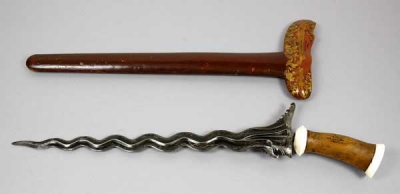Keris (1884.24.232)
 IndonesiaKeris from Bali?, Asia. Part of the Pitt Rivers Museum Founding Collection. Given to the Museum in 1884.
IndonesiaKeris from Bali?, Asia. Part of the Pitt Rivers Museum Founding Collection. Given to the Museum in 1884.
The keris (pronounced, and sometimes spelt as, 'kris') is a weapon from South East Asia, often recognisable by a wavy blade and asymmetrical, pistol-like grip designed for a thrusting action. It was believed to have originated as a good luck amulet in Java in the 14th century, at the time of the Hindu Majapahit Empire, although it later spread across Malaysia, Thailand and the Indonesian archipelago.
This is a Balinese keris, which is similar (though longer and larger), than Javanese forms. As the last Hindu bulwark in the predominantly Islamic Indonesia, Bali saw itself as the inheritor of the ancient Majapahit Indo-Javanese culture. Although long-bladed types of keris were used for performing executions in some Malay states, it is not an especially functional weapon. However, all of the its components, from the hilt shape to the blade to the sheath, are laden with symbolism, making this a weapon of divine power.
The Beautiful Warrior
In the areas where it spread, the keris was considered an integral part of a man's dress until the 19th century, when Dutch colonists probably put an end to the practice. The keris signified manhood and offered a magical potency that could assist its owner.
The blade of the keris represents a serpent. This is probably the naga of Hindu mythology, guardian of the earth's treasures. When the blade is straight, the serpent is at rest. The distinctive pattern-welding on the blade, known as pamor, is achieved by the smith layering wires or plates of pig iron and meteoric nickel steel, which he then folds and ripples into specific patterns. Several different kinds of pamor can be achieved by a skilled smith, who can give the blade a grain like wood, spots like leopard skin, and so on. Since the earthly serpent is formed of meteoric metal in this way, the keris succeeds in fusing the heavenly and the earthly.
Each keris has its own spirit, reflected by the blade shape and its individual pamor. It was considered important for a prospective owner to acquire a keris whose spiritual persona was compatible with his own. Only then could the weapon's mystical powers be used to his advantage. A keris could help keep disease away, ease the pain of childbirth, prevent quarrels, ensure victory in battle, extinguish fires and deter attacks by wild animals to mention but a few. Due to this extraordinary power, many keris were kept as family heirlooms. However, a keris placed in the wrong hands could create havoc and misfortune.
This particular Balinese keris has a flamboyant blade with many undulations, raised ridges running down its length, and a ganja (flared section of the blade near the hilt), which has been wrought in a very complex manner. The pamor is of the kenanga form, whose pattern mimics flowers of the same name.
A keris is considered incomplete without its sheath, which acts as its 'house' and keeps its power in check when at rest. The broad scabbard mouth, known as a sampir, is designed to accommodate the ganja and its shape may also represent the moonboat of Malay and Javanese legends. Here, it is slightly rounded and lacquered in a honey colour. The gold and black floral decoration alludes to the kenanga theme of the blade. Although many Balinese keris hilts are often miniature sculptures, representing gods and beasts, this hilt is quite plain. It is comprised of hardwood with a guard and pommel of ivory. The combination of the mystical and the aesthetic in this weapon meant it both beautified and protected the Balinese warrior who owned it, and also embodied something of his spirit that would remain with it through the centuries.





